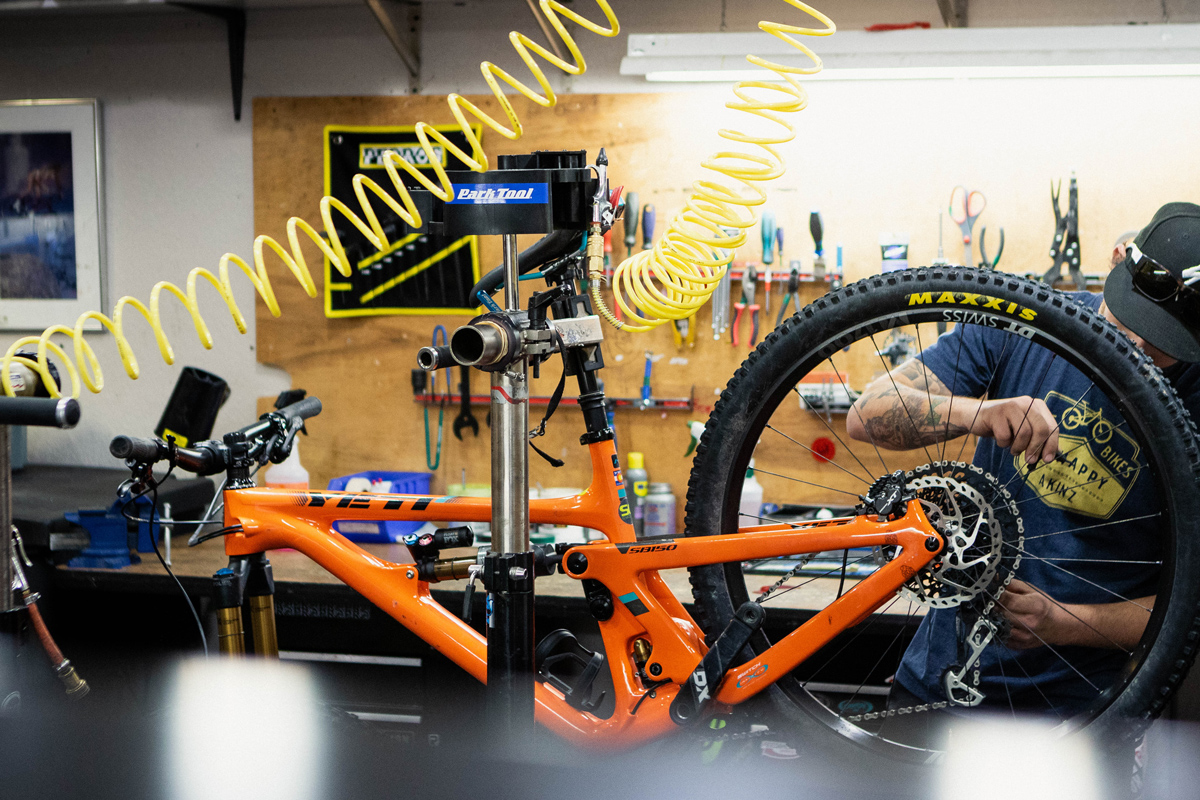
We’ve all been told a million times, but very few of us seem to do it. Nope, we aren’t talking about flossing—we’re talking about servicing your bike.
Your mountain bike (or gravel bike) is a big investment, and it’s one that we believe you should look after accordingly. With regular service you can extend the life of your beloved ride by years. Without? You’re looking at creaky components, leaky forks, a blown drivetrain, potential injury, and a much bigger price tag to fix things down the line. But just in case you aren’t convinced, let’s break down why it’s more affordable to choose ongoing maintenance—and exactly how you should schedule it out.
How can regular maintenance save me money—and keep me safe?
Sometimes it’s hard to understand why servicing your bike is important until it’s too late. Just ask our marketing hand Whitney, who found out why maintaining your drivetrain is important the hard way. (Knee cap to the frame—ouch!) But you don’t have to wait until your chain ring is geriatric to give it new life.
Keeping your chain clean and lubed for every ride and replacing it annually, or every 600-800 miles, will extend the life of other more expensive drivetrain components and ensure that the bike’s ride quality remains in top condition. As with many things mechanical, preventative measures like this can save you both the money and aggravation of a part’s untimely and outright failure, which leads to a significantly more expensive bill later on. Similarly, servicing your suspension for $130 is a lot more affordable than purchasing a new fork. (Those start at over $1,000.) Even if you service your suspension every year, it would take seven seasons of riding to get to that price!
Aren’t bikes built to handle this stuff?
Just imagine if every time you took your car for a drive it was down dirt roads, or through puddles, getting it caked with sand and sludge relentlessly. It can handle it, but it’s going to start degrading quickly. This is exactly how we treat our mountain and gravel bikes. While they’re hardy, they do require some attention. In order to keep our rides performing their best, lubricating their moving parts will keep them in excellent condition to continue pedaling smoothly and delivering on the big hits. That’s why servicing areas like the bottom bracket and seatpost are incredibly important. After all, if your dropper stops working at the top of a long descent, you’re going to regret it. Even for fair-weather riders who avoid the elements, that grueling climb to Gold Hill will stretch out your chain over time, jeopardizing the longevity of your drivetrain.
So what should I service, when?
The answer to this question depends on the amount of riding you do, as well as trail conditions. But for the average Colorado mountain biker who rides 2-4x/week, these are our recommendations. (Give us a ring or swing by for gravel recommendations.)
Every Ride
- Tire pressure
- Clean and lube the chain
Every 2-3 Months
- Add sealant to tubeless tires
- Assess brake pads
- Check the air pressure in your suspension
- Assess chain wear. We have a tool and are more than happy to measure chain wear.
- Assess brake rotor wear
Annually
- Replace tires
- Replace chain
- Brake system fluid flush including caliper cleaning and lube of pistons
- Replace cables
- Suspension Service
- Level 1 Tune: includes bearing assemblies, shifting and brake adjustments, and more
- Level 2 Tune: Level 1 Tune plus bottom bracket service, drivetrain analysis and deep clean, and more
The big question: how long should my bike last?
The answer to this question is different for everyone, but if you take care of it properly, your bike has no expiration date. We know some athletes who prefer to continue regular maintenance on their bike for years–even going so far as to give it a fresh paint job–before purchasing a new one. Other riders prefer to upgrade to the newest release every few seasons to take advantage of the latest tech and the excellent resale value of their old bikes. (Hint: well-maintained pre-owned bikes sell for a lot more.). No matter which path you choose, maintaining your bike promotes its longevity so that you or someone else can enjoy it for seasons to come. And that’s a sustainable effort we can get behind.
Interested in learning more about keeping your bike rolling? Discover all there is to know about suspension maintenance, here.
